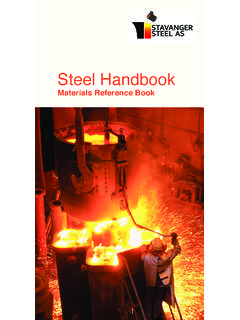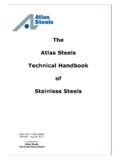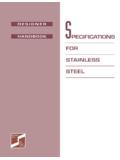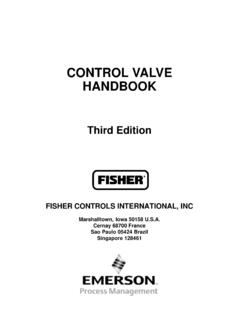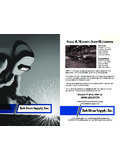Transcription of Steel Handbook - stavangersteel.no
1 Steel HandbookMaterials Reference Book32 Dear customerWe hope this book will prove useful to you as a practical Steel reference guide. We have also made it small enough to comfortably carry around with you. Please just let us know if you would like additional regards, Stavanger Steel ASSt lverksvegen 51N-4100 J RPELANDNORWAYTel: +47 51 74 34 00 : of this bookAs well as an introduction to SSA and our products, you will find a lot of useful information about Steel and stainless Steel , corrosion resistance, mechanical properties, heat treatment, welding, casting and forging, testing and addition, the conversion tables we have included for units, temperature and mechanicalproperties should be useful too.
2 We have alsopresented an overview of the different Steel grades we supply, and the way they meetinternational and other Steel ASSSA is part of a long and proud industrial tradition. Stavanger Electro Staalverk A/S was established in J rpeland, Norway in 1911. Scana Steel Stavanger AS operated on the same site between 1991 and 2015, and now Stavanger Steel AS carries on that tradition as Norway`s sole special-ized steelworks, and one of Europe`s leading suppliers of forged and cast Steel intend to build on this tradition and develop SSA based on the good standing, performance and expertise of the company.
3 Our main product segments will continue to be cast and forged Steel components for a range of different markets. As an exclusive supplier, SSA offers a one-stop-shop - service to our customers. Through our partnerships with qualified suppliers we process components from melted scrap Steel through the entire production process, including heat treatment, machining, NDE, testing of mechanical properties, surface treatment and assembly. SSA also offers elements of this process as stand-alone our high level of flexibility we can meet all market demands with short delivery times and excellent quality.
4 SSA also offers design and material engineering support provided by highly qualified staff in our technical organizes the classification and inspection of all components, saving our customers valuable time. SSA operates a professional laboratory at our production site, which, in addition to being an important element in our internal quality assurance regime, meets or exceeds the require-ments of third party classification working closely with reliable partners in Norway and abroad, SSA will be able to meet all the requirements the market demands. By combining over one hundred years of industrial tradition with modern expertise and excellence in all of our activities, we live up to our name Stavanger Steel properties depends on chemical composition and heat treatmentCorrosion resistanceIn general terms, Steel is said to be stainless whenchromium content is above %.
5 Adding morechromium, molybdenum and nitrogen further increases corrosion stainless Steel grades may contain 25 % Cr, 7 % Mo and some nitrogen, resulting in a PRE value above 40. PRE is an empirical formula designed for the highest class of stainless = Pitting Resistant Equivalent PRE = %Cr + 3,3 %Mo + 16 %N. Small amounts of Nitrogen (N) have a significanteffect on the corrosion resistance and alsostabilize austenitic structure. Nickel (Ni) is a common alloying element in stainless steels and is added for stabilizing the austenitic selectionProper materials selection is vital for the lifetimeof the Steel .
6 Knowledge about exposure to internal or external corrosive media is a key consideration in making the correct choices. Temperature, pres-sure, concentration of corrosive media, flow rate, design and physical connection to other materials are also of crucial corrosion resistance is not the only thingto consider. Strength, toughness and weldabilityare other important factors. You may find an alloy in our tables of Steel grades that meets many of your needs. SSA manufactures a wide selection of forged and cast corrosion-resistant Steel alloys. With our wide experience of many different applications, we can help you in making the best materials selection.
7 Depending on your precise needs, we can also manufacture customised Steel grades to your specifications. Our highly efficient production processes enable us to produce anything from small one-off orders to larger properties of stainless Steel alloysMechanical properties are a consequenceof material structure and are determined by the type and amount of alloying elements and subsequent heat treatment. stainless Steel alloys may be grouped into hardenable (martensitic) and non-hardenable (austenitic and duplex) stainless steels like SSA gradesS316L / S128 MIII super have low yield strength,although their hardness and strength can be increased by adding Cr and Mo (6Mo Steel ).
8 Austenitic steels are very ductile and tough (impact test at -196 C) and are stainless steels like S8490 ( duplex ) and SAF2507 ( super duplex ) have excellent corrosion resistance combined with high strength,due to their fine grained two-phase structure. Martensitic stainless steels like S134M and S165M are tough even though they have been hardened to a high tensile strength of 800-1,000 MPa. The tempering temperature is vital for strength and toughness. Higher temperature increases toughness and decreases strength, and vice versa. SSA will be pleased to help you find the optimal properties for your treatment arranged by typeExcept from billets in some grades Steel products never leaves the SSA plant without having been heat treated, because this is vital for achieving optimal physical properties.
9 Below, you will find an overview of the most common types of heat treatment in Steel production:Normalising is a heat treatment performed on carbon-manganese Steel by heating to about900 C and cooling in air. The micro structure is named ferrite-perlite. Stress-relieving at about 600 C for reducing stress after welding to cast Steel will not affect the structure of normalized Steel , but will temper hard zones (HAZ) around the weld and tempered (QT) describes a two-step heat treatment process: first heating to about 900 C and then fast-cooling in water or polymer emulsion.
10 The next step is the temper-ing, with the temperature depending on the Steel grade and the specification of hardness/strength and toughness. In general terms, low temperature is used to achieve high strength and low toughness, and vice versa. High alloyed hardenable Steel may be allowed to cool in oil or air to annealing describes a heat treatmentSolution annealing describes heat treatment used for austenitic and duplex Steel heating to about 1,000 -1,200 C followed by rapid cooling, the alloy will have a homogenous structure with no detrimental precipitation that may cause reductions in corrosion resistance or relieving is performed to reduce stressafter non-uniform shrinkage caused by cooling,or after welding.
